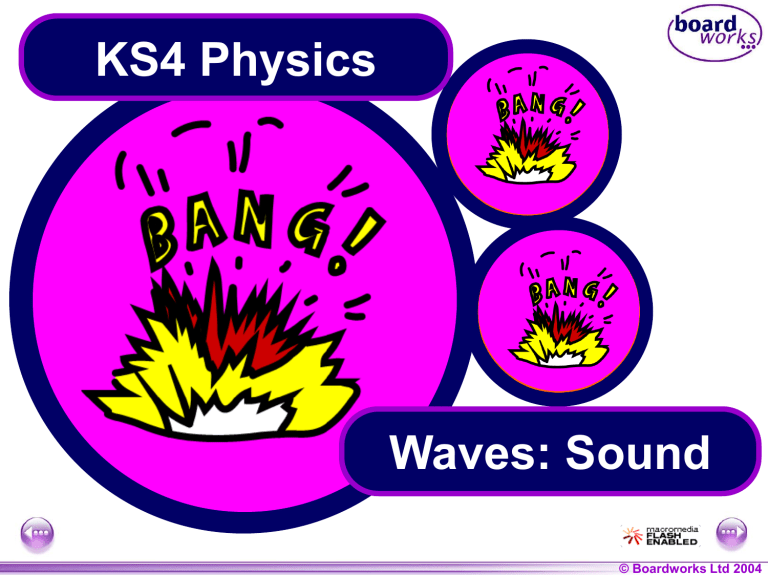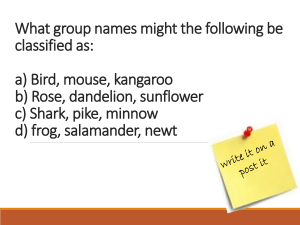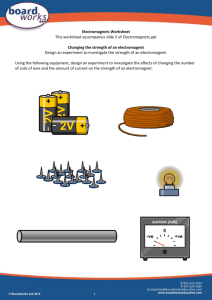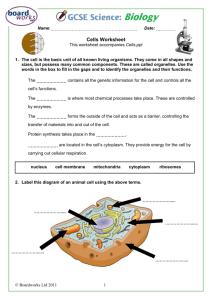
KS4 Physics Waves: Sound © Boardworks Ltd 2004 Contents Waves: Sound What is sound? Sound and reflection Structure of sound waves Hearing sound Ultrasound © Boardworks Ltd 2004 What causes sound? Take a tuning fork and strike it against a block of wood. What do you observe? The tuning fork vibrates and you hear a sound. Sounds are made when an object vibrates. © Boardworks Ltd 2004 Good vibrations! What vibrates so that the following make sounds? violin strings drum skin voice box loudspeaker cone © Boardworks Ltd 2004 How does sound travel? How does sound reach your ear? longitudinal wave When the drum skin is struck, it vibrates which causes the air beside the drum to vibrate. The compression and stretching of air particles creates a sound wave which is carried through the air to your ear. What type of wave is a sound wave? © Boardworks Ltd 2004 Describe how the movement of loudspeaker cone produces regions of high pressure (compressions) and low pressure(rarefactions) . High pressure : cone moves forward or in the direction of travel of wave OR cone pushes air particles closer Low pressure : cone moves backward or away from direction of travel of wave OR cone causes empty spaces. © Boardworks Ltd 2004 Define wavelength of sound in terms of compressions. Wavelength is the distance between two successive/adjacent compressions. Define frequency of sound in terms of compressions. Frequency is the number of compressions passing a point per second. © Boardworks Ltd 2004 The bell-jar experiment Place a ringing clock inside the bell jar and what happens? There is air inside the bell jar so the sound can travel and be heard. vacuum pump on Remove the air from the bell jar and what happens to the sound? With a vacuum inside the bell jar, the sound cannot be heard. Why? © Boardworks Ltd 2004 How fast does sound travel? You need a quiet open space at least 100 m long to perform this investigation. START STOP 00:0034 00 100 m 1. When you see the cymbals crash, press START. 2. When you hear the cymbals crash, press STOP. © Boardworks Ltd 2004 How fast does sound travel? Record the results of your sound experiments in a table. sound distance (m) time (s) speed (m/s) 1 100 0.34 294 2 3 4 How are these values used to estimate the speed of sound? 100 distance = = 294 m/s speed = time 0.34 © Boardworks Ltd 2004 How fast does sound travel? The speed of sound in air is about… 340 m/s Use the results of the cymbals experiment to calculate your average speed of sound. How does your calculation for the average speed of sound compare with the real speed? What errors could have affected the results of your cymbals experiment? Do you think the speed of sound in water is the same as it is in air? © Boardworks Ltd 2004 Different speeds of sound © Boardworks Ltd 2004 Sound and states of matter Sound waves need a substance to travel through. What are all substances made of? solid particles liquid gas What is the particle model of a solid, a liquid and a gas? In which state are the particles closest together? solid In which state are the particles furthest apart? gas © Boardworks Ltd 2004 Sound and states of matter Sound waves travel by particles vibrating. What state does sound travel fastest through and why? solid liquid gas Sound waves travel fastest through solids. The particles in a solid are closer together than in a gas or a liquid. This means vibrations are more easily passed from particle to particle and so sound waves travels faster. © Boardworks Ltd 2004 Sound or light – which is faster? During a thunderstorm, thunder and lightning are created at the same time. Which do you notice first? Usually, you see lightning before you hear thunder . Light travels much faster than sound. The speed of light is… 300 000 000 m/s How much faster is light than sound? How could you use thunder and the speed of sound to estimate how far away a thunderstorm is? © Boardworks Ltd 2004 During a thunderstorm, the thunder was heard 3.6 s. If the speed of sound in air is 330 m/s, how far away is the thunderstorm ? © Boardworks Ltd 2004 ASSUMPTION USED FOR THIS CALCULATIONS • Light travels instantaneously • Distance of thunderstorm same as distance travelled by sound. • Thunder and lightening caused by same event • Negligible wind © Boardworks Ltd 2004 Breaking the sound barrier! Which of these travel faster than the speed of sound in air? distance (m) time (s) speed (m/s) small aeroplane 600 5 120 jet fighter 900 2 450 cheetah 50 2.5 20 meteorite 10 000 0.35 28 571 The jet fighter and the meteorite break the sound barrier. What does this mean? © Boardworks Ltd 2004 Contents Waves: Sound What is sound? Sound and reflection Structure of sound waves Hearing sound Ultrasound © Boardworks Ltd 2004 Reflected sound waves What happens when a sound wave meets a hard flat surface? The sound wave is reflected back from the surface. What type of sound does this produce? echo © Boardworks Ltd 2004 Experiment on echoes Stand at least 100 m from a large, flat wall with a stop watch. START 150 m STOP 1. Use a starting pistol (or clapper board) to make a sound. 2. Measure the time taken between firing the pistol and hearing the echo. How far does the sound travel? © Boardworks Ltd 2004 Experiment on echoes The sound of the starting pistol takes 0.92 s to travel a distance of 300 m. How can you use this result to estimate the speed of sound? distance speed = time = 300 0.92 = 326 m/s Repeat the experiment several times to obtain an average. How does your calculation for the average speed of sound compare with the real speed? © Boardworks Ltd 2004 METHOD 1 • Distance in field measured with tape • One student fires pistol at one end (of this distance) • Student at other end starts stop-watch on seeing smoke/light from pistol and stops stopwatch on hearing sound of pistol • Speed =(measured)distance/(measured)time © Boardworks Ltd 2004 METHOD 2 • Distance of 50 m or more from a vertical wall measured with tape • Student 1 fires pistol at this from the wall • Student 2 standing next to student 1 starts stop-watch on hearing pistol and stops stopwatch on hearing echo • Speed= 2 x (measured) distance / (measured) time © Boardworks Ltd 2004 Echoes and reflection What do we call reflected sound? an echo Are hard or soft surfaces best at reflecting sound? Hard surfaces produce strong echoes. How are echoes reduced in cinemas and theatres? By using soft materials on the walls such as curtains. Name two animals that use echoes for navigation or communication. bats and dolphins © Boardworks Ltd 2004 Contents Waves: Sound What is sound? Sound and reflection Structure of sound waves Hearing sound Ultrasound © Boardworks Ltd 2004 Wednesday, May 1, 2024 X’teristics of sound waves WALT describe the characteristics and properties of sound waves. Key Words pitch loudness © Boardworks Ltd 2004 Studying sound waves Sound waves can be studied with this type of equipment. loudspeaker oscilloscope signal generator Which piece of equipment… • produces signals over a range of signal generator frequencies and of varying amplitudes? • converts signals into sound waves? loudspeaker • is used to study the frequency and loudness of a sound? oscilloscope © Boardworks Ltd 2004 Why sound is quiet or loud? What is the difference between the sound wave of a quiet sound and a loud sound? quiet sound loud sound The loud sound has taller waves. The louder the sound, the greater the amplitude. What would the sound wave of a very loud sound look like? © Boardworks Ltd 2004 Which is the loudest? Which trace represents the loudest sound? A B Sound A is the loudest. Sound A has the largest amplitude, which means the wave has more energy and so the sound is louder. © Boardworks Ltd 2004 Why sound is low pitch or high pitch? What is the difference between the sound wave of a low pitch sound and a high pitch sound? low pitch sound high pitch sound The high pitch sound has a shorter wavelength, so more waves are visible. It has higher frequency waves. What would the sound wave of a very low sound look like? © Boardworks Ltd 2004 Which is the highest? Which trace represents the sound with the highest pitch? A B Sound B is the highest pitched. Sound B has the shortest wavelength and the most number of waves visible, so it has the highest frequency. © Boardworks Ltd 2004 USING THE REPRESENTATION OF SOUND WAVE What would change if the sound had a higher frequency? Compressions and/or rarefactions closer together OR more compressions and/or rarefactions. What would change if the sound were louder? Layers closer together at compressions Layers further apart in rarefactions. © Boardworks Ltd 2004 Wave animation © Boardworks Ltd 2004 Contents Waves: Sound What is sound? Sound and reflection Structure of sound waves Hearing sound Ultrasound © Boardworks Ltd 2004 How does the ear hear? 1.Sound waves are collected by the ear lobe or pinna. 6.The auditory nerve takes the signals to the brain. 6 4 1 2 3 5 2.The waves travel along the ear canal. 5.The cochlea turns these into electrical 4.The small bones 3.The waves signals. (ossicles) amplify make the ear the vibrations. drum vibrate. © Boardworks Ltd 2004 How does the ear hear? © Boardworks Ltd 2004 Can we hear all frequencies? Set the volume and increase the frequency of the signal provided by the signal generator. Humans cannot hear sounds of every frequency. The range of frequencies you can hear is called your hearing range. What is the hearing range of a healthy young person? 20 Hz to 20 000 Hz © Boardworks Ltd 2004 Do we have the same hearing? Does everyone have the same hearing range? We all have slightly different hearing ranges but almost 1 in 5 people suffer some sort of hearing loss. Temporary hearing loss may be caused by ear infections and colds after which hearing recovers. Permanent hearing loss and deafness can be present at birth or occur if the ear is damaged or diseased. People lose the ability to hear sounds of high frequency as they get older. Which end of their hearing range will be affected? © Boardworks Ltd 2004 Comparing hearing ranges Do all animals have the same hearing range? 100 000 10 000 1 000 frequency 100 (Hz) 10 1 0 human dog bat elephant mouse dolphin © Boardworks Ltd 2004 How is loudness measured? The loudness of a sound is measured in decibels (dB). 0 dB = quietest audible sound (near total silence) 10 dB = 10 times more powerful than the quietest sound 20 dB = 100 times more powerful than the quietest sound How much more powerful than the quietest sound is 30 dB? 1000 times A whisper is 30 dB and normal conversation is 60 dB. How much more powerful is normal conversation compared to a whisper? 1000 times © Boardworks Ltd 2004 When is sound dangerous? Any sound above 85 dB can damage hearing. You know you are listening to 85 dB sound if you have to raise your voice to be heard. What might also influence hearing loss? The amount of time spent listening to a loud sound also causes hearing problems. Any 140 dB sound causes pain and immediate damage! More than two hours of 100 dB sound can damage your ears. Why are there laws about the maximum levels of sound that people should be exposed to at work? © Boardworks Ltd 2004 What is noise? A noise is any unwanted sound. What one person considers noise another person might not. Can you name any examples? List three effects of noise. headaches nausea deafness List three ways of reducing the effects of loud noise. ear protectors double glazing putting noisy machinery in insulated rooms © Boardworks Ltd 2004 How loud is loud? decibels aircraft overhead 160 personal stereo 140 permanent ear damage 120 100 loud bell 80 quiet countryside 60 40 pin being dropped circular saw at 2m 20 0 can just be heard © Boardworks Ltd 2004 How is hearing tested? The results of a hearing tested are shown on an audiogram. intensity of sound (dB) 80 70 loud sound 60 50 optimal hearing 40 impaired hearing 30 moderate sound 20 soft sound 10 0 0 2000 4000 6000 8000 Frequency of of sound frequency sound[Hz] (Hz) low pitch high pitch The audiogram shows hearing sensitivity for different frequencies (pitch) at different intensities (volume). It records the softest sound heard at each pitch . © Boardworks Ltd 2004 Testing hearing Which audiogram trace represents optimal hearing and which represents impaired hearing? intensity of sound (dB) 80 impaired hearing 70 60 50 optimal hearing 40 impaired hearing 30 optimal hearing 20 10 0 0 2000 4000 6000 8000 [Hz] of sound Frequencyof frequency sound (Hz) © Boardworks Ltd 2004 Contents Waves: Sound What is sound? Sound and reflection Structure of sound waves Hearing sound Ultrasound © Boardworks Ltd 2004 Wednesday, May 1, 2024 Ultrasound WALT Describe some applications of ultrasound. Key Words Ultrasonic Echo-sounder © Boardworks Ltd 2004 What is ultrasound? The upper frequency limit of human hearing 20 000 Hz. Any high frequency sound above 20 kHz is called… ultrasound Whales and dolphins communicate using ultrasound. Why does a dog whistle vibrate at ultrasound frequencies? Can you name another human use of ultrasound? © Boardworks Ltd 2004 © Boardworks Ltd 2004 Using ultrasound Which of the following does not use ultrasound? imaging fetuses dolphins jewellery cleaning ultrasonic toothbrush viewing kidney stones bats ultrasonic cleaning echo location submarines It’s a trick question! All of the above involve ultrasound. High frequencies can be very useful! © Boardworks Ltd 2004 Using ultrasound in medicine Ultrasound is the name given to a medical technique. It uses high frequency sound waves to produce images of inside the body without opening up the body. fetus at 10 weeks fetus at 20 weeks ultrasound for scanning fetuses instead of X XWhy raysisare more energetic and penetrating and are a rays lot more which would give a clearer dangerous, they could causepicture? damage to the growing baby. © Boardworks Ltd 2004 How does ultrasound imaging work? Ultrasound, like all sound, is reflected when it meets different boundaries. So how is this used for imaging? An ultrasound machine transmits high-frequency sound waves into the body. These sound waves are reflected different amounts by different tissues. The reflected waves are detected by a receiver. A computer turns the distance and intensities of these echoes into a two-dimensional image. © Boardworks Ltd 2004 ULTRASOUND IS PREFERRED TO X-RAY SCAN X-rays can cause cell damage inside a growing baby Ultrasound can distinguish between different layers of soft tissue, which an ordinary X-ray machine cannot © Boardworks Ltd 2004 NON-DESTRUCTIVE TESTING OF MATERIALS (METAL TESTING) • A pulse of ultrasound is sent through the metal • If there is a flaw(tiny gap) in the metal, two reflected pulses are picked up by the detector. • The pulse reflected from the flaw returns first, followed by the pulse reflected from the far end of the metal. • The pulses are displayed using an oscilloscope © Boardworks Ltd 2004 © Boardworks Ltd 2004 DISCUSS THE USE OF ULTRASOUND TO DETERMINE THE SIZE AND POSITION OF A BUBBLE INSIDE A METAL BLOCK • Use of transducer to send and receive pulses of ultrasound • (display used to determine) time for echo of pulse to return from front AND back of bubble. • Use of speed of sound in the metal • Use of distance = speed x time to calculate position and size. © Boardworks Ltd 2004 ECHO-SOUNDING ( SONAR ) © Boardworks Ltd 2004 If a pulse of ultrasound takes 0.1 s to travel to the sea-bed and return, and the speed of sound in water is 1400 m/s Distance travelled = speed x time = 1400m/s x 0.1s = 140 m Depth of water = ½ x 140 m = 70 m © Boardworks Ltd 2004 Sound multiple choice © Boardworks Ltd 2004



